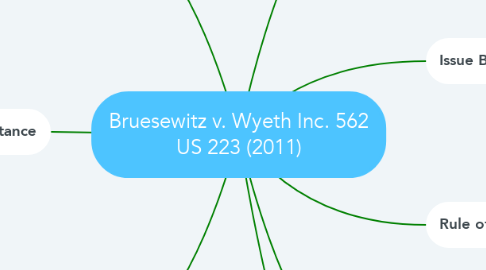
1. Facts
1.1. Parties
1.1.1. Hannah Bruesewitz (injured party, minor)
1.1.2. Russell and Robalee Bruesewitz (parents of Hannah)
1.1.3. Wyeth Inc., a Pharmaceutical Company
1.2. What Happened
1.2.1. Hannah received a diphtheria, tetanus and pertussis vaccine from her physician.
1.2.2. Very shortly after, she started having seizures, was hospitalized for a considerable amount of time, and has experienced a residual seizure disorder requiring ongoing medical care.
1.3. Procedural History
1.3.1. State-level court judge dismissed the case based on protections afforded to the pharmaceutical industry by the National Childhood Vaccine Injury Act (NCVIA)
1.3.1.1. US Court of Appeals for the 3rd Circuit affirmed this decision.
2. Issue Before the Court
2.1. "Can a federal law shield vaccine manufacturers from certain product liability lawsuits in state court that seek damages for serious health problems suffered by children?" ("Bruesewitz v. Wyeth Inc." Oyez, 12 Nov. 2017, www.oyez.org/cases/2010/09-152)
3. Rule of Law
3.1. NCVIA
3.1.1. Enacted in 1986 -- put into place a "no-fault compensation program" that allows injured persons to file a claim for damages caused by a vaccination.
3.1.1.1. Injured parties must file a claim for any damages over $1000.
3.1.1.2. The claimant can either accept the decision its subsequent compensatory award or reject the decision and file a tort suit to recover damages.
3.1.1.3. Claimants do not need to prove the vaccine was defectively manufactured, labeled, or designed. This burden of proof would be on the plaintiff during a tort suit.
4. Application
4.1. The Act states, "“No vaccine manufacturer shall be liable in a civil action for damages arising from a vaccine-related injury or death associated with the administration of a vaccine after October 1, 1988, if the injury or death resulted from side effects that were unavoidable even though the vaccine was properly prepared and was accompanied by proper directions and warnings.” (42 U. S. C. §300aa–22(b)(1))
4.1.1. The US Supreme Court's opinion centered around the word "unavoidable" and the ways in which a company must attempt to prevent any "avoidable" side effects.
4.1.1.1. It was determined that the design of the vaccine cannot be seen as avoidable and thus not questionable in a tort suit.
4.1.1.2. The Act was interpreted to suggest that the word "avoidable" must be used in regards to the current design as opposed to any other possible design, as there are always alternatives.
5. Conclusion
5.1. The US Supreme Court ruled that the NCVIA prevents pharmaceutical companies from claims regarding design defects that have caused side effects as a result of a patient receiving a vaccination. As such, the lower court's decision was affirmed.
6. Impact
6.1. Milik v Secretary of Health and Human Services
6.1.1. A patient's parents claimed the child's severe neurological condition involving developmental delay, spastic diplegia, and motor difficulties were the result of a vaccine. Milik v. Sec'y of Health & Human Servs., 822 F.3d 1367 (Fed. Cir. 2016), cert. denied sub nom. Milik v. Price, 137 S. Ct. 2206, 198 L. Ed. 2d 254 (2017)
6.1.1.1. It was argued that Bruesewitz v Wyeth Inc laid groundwork the required the Court of Federal Claims was required to review the decision of the special master regarding an NCVIA claim.
6.1.1.2. This argument was found to not be the case, as it was stated that a petitioner has the right to appeal the decision or reject the decision and proceed with a tort suit.
6.2. Holmes v Merck & Co, Inc.
6.2.1. Parents of a patient who passed away after receiving a vaccination manufactured by the defendant filed a tort suit in hopes of receiving compensation for the death of their child.
6.2.1.1. The court, referencing Bruesewitz v Wyeth Inc, ruled that the NCVIA preempted a tort suit due to claimed defects in a vaccine that caused an unavoidable side effect.

